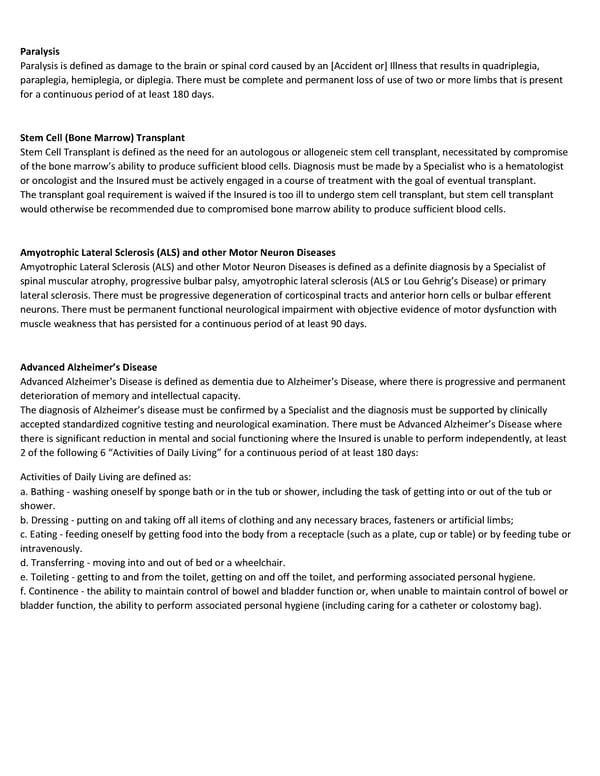Paralysis Paralysis is defined as damage to the brain or spinal cord caused by an [Accident or] Illness that results in quadriplegia, paraplegia, hemiplegia, or diplegia. There must be complete and permanent loss of use of two or more limbs that is present for a continuous period of at least 180 days. Stem Cell (Bone Marrow) Transplant Stem Cell Transplant is defined as the need for an autologous or allogeneic stem cell transplant, necessitated by compromise of the bone marrow’s ability to produce sufficient blood cells. Diagnosis must be made by a Specialist who is a hematologist or oncologist and the Insured must be actively engaged in a course of treatment with the goal of eventual transplant. The transplant goal requirement is waived if the Insured is too ill to undergo stem cell transplant, but stem cell transplant would otherwise be recommended due to compromised bone marrow ability to produce sufficient blood cells. Amyotrophic Lateral Sclerosis (ALS) and other Motor Neuron Diseases Amyotrophic Lateral Sclerosis (ALS) and other Motor Neuron Diseases is defined as a definite diagnosis by a Specialist of spinal muscular atrophy, progressive bulbar palsy, amyotrophic lateral sclerosis (ALS or Lou Gehrig’s Disease) or primary lateral sclerosis. There must be progressive degeneration of corticospinal tracts and anterior horn cells or bulbar efferent neurons. There must be permanent functional neurological impairment with objective evidence of motor dysfunction with muscle weakness that has persisted for a continuous period of at least 90 days. Advanced Alzheimer’s Disease Advanced Alzheimer's Disease is defined as dementia due to Alzheimer's Disease, where there is progressive and permanent deterioration of memory and intellectual capacity. The diagnosis of Alzheimer’s disease must be confirmed by a Specialist and the diagnosis must be supported by clinically accepted standardized cognitive testing and neurological examination. There must be Advanced Alzheimer’s Disease where there is significant reduction in mental and social functioning where the Insured is unable to perform independently, at least 2 of the following 6 “Activities of Daily Living” for a continuous period of at least 180 days: Activities of Daily Living are defined as: a. Bathing - washing oneself by sponge bath or in the tub or shower, including the task of getting into or out of the tub or shower. b. Dressing - putting on and taking off all items of clothing and any necessary braces, fasteners or artificial limbs; c. Eating - feeding oneself by getting food into the body from a receptacle (such as a plate, cup or table) or by feeding tube or intravenously. d. Transferring - moving into and out of bed or a wheelchair. e. Toileting - getting to and from the toilet, getting on and off the toilet, and performing associated personal hygiene. f. Continence - the ability to maintain control of bowel and bladder function or, when unable to maintain control of bowel or bladder function, the ability to perform associated personal hygiene (including caring for a catheter or colostomy bag).
 Critical Illness Benefits Summary Page 4 Page 6
Critical Illness Benefits Summary Page 4 Page 6